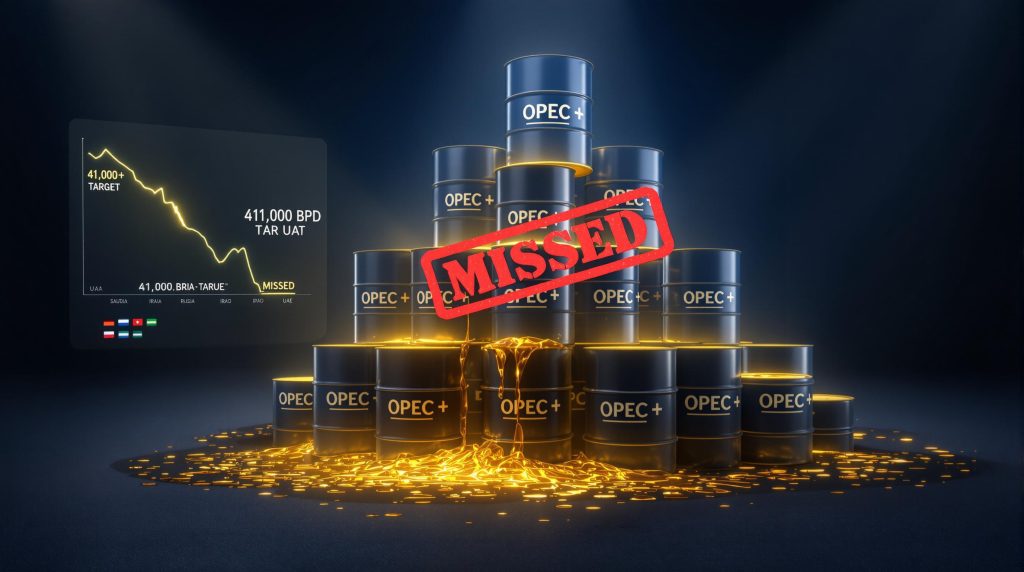Why Did OPEC+ Miss Its Production Targets in July?
OPEC+ production fell short of its planned 411,000 barrels per day (bpd) increase in July, continuing a pattern of underproduction that has characterized the oil alliance in recent months. The gap between announced targets and actual output has become increasingly significant, creating ripples throughout global energy markets and affecting price dynamics worldwide.
The production deficit stems from a complex interplay of factors that vary significantly across the alliance's diverse membership. While some producers face genuine technical constraints, others may be strategically managing their output levels to optimize market conditions and revenue streams.
Production Shortfalls by Country
The production shortfall has not been distributed evenly across the OPEC+ coalition. Several key producers have experienced particularly notable difficulties in meeting their allocated quotas:
- Nigeria continues struggling with pipeline sabotage, theft, and maintenance issues at major facilities, keeping production well below target levels
- Angola faces declining output from aging offshore fields and insufficient investment in new developments
- Iraq has consistently underperformed despite substantial reserves, hampered by infrastructure limitations
- Kazakhstan experienced technical difficulties at its flagship Tengiz and Kashagan fields
- Russia has maintained production below its target amid ongoing export challenges and Western sanctions
These individual country challenges collectively contribute to the overall alliance shortfall, though with varying degrees of severity and underlying causes.
Technical and Infrastructure Limitations
Behind the headline production figures lie significant technical barriers that prevent many OPEC+ members from rapidly increasing their output:
- Field maturity issues affect numerous producers, particularly those with decades-old reservoirs experiencing natural decline rates
- Maintenance backlogs accumulated during pandemic-era production cuts have proven difficult to address
- Investment shortfalls over multiple years have limited the development of new capacity
- Technical expertise gaps in some member countries hinder optimal field management
- Infrastructure bottlenecks including insufficient pipeline capacity, processing facilities, and export terminals
For many OPEC+ members, these technical constraints represent genuine physical limitations rather than policy choices, making compliance with higher production targets extraordinarily difficult regardless of intent.
How Does This Shortfall Impact Global Oil Markets?
The gap between OPEC+ announced production increases and actual output has significant implications for global energy markets, especially as traders and analysts try to gauge true supply conditions.
Price Implications
The consistent production shortfall creates several important market dynamics that influence global oil prices:
- Tighter effective supply than officially projected by OPEC+ statements and communiqués
- Price support mechanisms functioning through invisible production restraint
- Market uncertainty premium as traders question the reliability of production targets
- Partial offset against bearish factors like Chinese demand weakness
- Reduced buffer capacity to respond to supply disruptions elsewhere
Current price levels reflect this reality, with WTI crude trading at $63.25 and Brent at $66.12 as of August 2025 data. These prices remain relatively firm despite economic headwinds, partially due to the ongoing supply constraint from OPEC+ underproduction.
Market Balance Assessment
The consistent gap between planned and actual OPEC+ production significantly affects the global oil supply-demand balance:
- Creates discrepancies between official OPEC+ statements and market reality
- Complicates forecasting efforts by energy analysts and trading firms
- May lead to faster inventory drawdowns if demand remains robust
- Reduces actual supply cushion against potential disruptions
- Creates persistent uncertainty about true market tightness
This ambiguity benefits OPEC+ in some ways, allowing the alliance to maintain price support without officially announcing additional cuts that might trigger political backlash from consuming nations. Additionally, the recent US oil production decline has further tightened global supplies, amplifying the impact of OPEC+ underproduction.
What Are OPEC+ Production Compliance Rates?
Compliance metrics provide critical insight into the gap between OPEC+ promises and performance. Understanding these patterns helps market participants anticipate actual supply conditions beyond official announcements.
Historical Compliance Patterns
OPEC+ has established distinct patterns in its adherence to production agreements over time:
- During price crashes, compliance typically improves as members recognize mutual benefit
- During strong markets, compliance often weakens as incentives to cheat increase
- Technical constraint-driven underproduction creates "involuntary compliance"
- Key Gulf producers often compensate for others' overproduction through additional cuts
- Overall compliance typically exceeds 100% when including involuntary underproduction
This complex compliance history reveals the inherent tensions within the alliance between individual member interests and collective market management goals. Furthermore, the latest oil price rally analysis suggests that market participants are factoring in OPEC+ compliance patterns when placing their bets.
July Compliance Analysis
The July production figures demonstrate continuing patterns in OPEC+ production discipline:
- Overall compliance exceeded 100% due to widespread underproduction
- Several key producers failed to meet their individual quotas by significant margins
- The gap between allocated and actual production widened compared to June
- Voluntary additional cuts by Saudi Arabia and other Gulf producers remained in place
- Few members successfully reached their full production quota allocation
These compliance figures underscore the structural nature of the production shortfall, suggesting it may persist in coming months despite official targets for continued increases.
Which Countries Led OPEC+ Production in July?
Understanding the production hierarchy within OPEC+ provides insight into which members have the greatest influence over market outcomes and production decisions.
Top Producers by Volume
Despite the overall alliance shortfall, several key OPEC+ members maintained significant production levels:
- Saudi Arabia remained the group's largest producer at approximately 9.95 million bpd
- Russia maintained its position as second-largest producer at around 9.45 million bpd
- Iraq continued as the third-largest producer at approximately 4.20 million bpd
- UAE ranked fourth with production near 3.15 million bpd
- Kuwait rounded out the top five producers at about 2.60 million bpd
These five countries collectively account for nearly 75% of total OPEC+ production, highlighting their outsized influence within the alliance despite having only 5 votes among 23 member countries.
Production Changes by Country
Month-over-month production changes varied significantly across the alliance in July:
- Saudi Arabia maintained stable production, focusing on price over volume
- Russia showed minimal change amid ongoing export challenges
- Iraq experienced slight declines due to maintenance at southern fields
- Kazakhstan saw modest recovery from earlier technical difficulties
- Nigeria continued to struggle with persistent production challenges
- Libya experienced volatility due to ongoing political uncertainties
These varied outcomes reflect the different circumstances, capacities, and priorities of OPEC+ members, highlighting the challenge of coordinating such a diverse group. Recent trade war oil trends have added another layer of complexity to the production decisions of various OPEC+ members.
What Factors Constrain OPEC+ Production Capacity?
The persistent underproduction by OPEC+ members reflects fundamental constraints beyond short-term policy choices. Understanding these limitations is essential for realistic market analysis.
Investment Challenges
Long-term underinvestment has created structural limitations for many producers:
- Capital expenditure reductions during price downturns have limited capacity growth
- Project delays during the pandemic continue to affect current production potential
- Financing challenges for national oil companies in several member states
- Shifting focus toward maintaining existing production rather than expansion
- Uncertain energy transition timeline creating hesitation for long-term projects
These investment patterns take years to reverse, meaning that even with improved market conditions, production capacity constraints may persist well into the future.
Technical and Operational Issues
Beyond investment constraints, operational factors significantly impact production capacity:
- Natural decline rates in mature fields require ongoing investment just to maintain output
- Reservoir management challenges in complex geological formations
- Skilled labor shortages in some producing regions
- Supply chain disruptions affecting equipment availability and maintenance schedules
- Water management issues in aging fields with increasing water cut
These technical challenges often receive less attention than policy decisions but can have equal or greater impact on actual production capabilities, especially for producers with aging asset bases. According to recent OPEC data from Reuters, these operational challenges have been particularly acute in several West African producers.
How Will OPEC+ Respond to Production Shortfalls?
The persistent gap between targets and actual output creates both challenges and opportunities for OPEC+ policymaking. The alliance must navigate complex internal and external factors in determining its response.
Policy Options
The alliance has several potential responses to address the production gap:
- Adjust official production targets downward to better align with actual capacity
- Redistribute quotas among members with available capacity
- Extend the current agreement duration to manage market expectations
- Maintain current policy while accepting compliance above 100%
- Accelerate investment initiatives to address capacity constraints
Each option carries different implications for market perception, internal alliance politics, and price outcomes, creating a complex decision environment for OPEC+ ministers.
Strategic Considerations
OPEC+ decision-making balances multiple strategic factors beyond simple production economics:
- Market share preservation versus price support objectives
- Relationship management among diverse member states with varying priorities
- Response to changing demand forecasts from major consuming nations
- Competition from non-OPEC producers, particularly U.S. shale operators
- Geopolitical pressures from consuming nations concerned about energy costs
These complex considerations mean that OPEC+ responses may not always follow predictable economic logic, as they must balance technical realities with political necessities and long-term strategic goals. The comprehensive oil futures overview provides additional context for understanding how market participants are positioning themselves based on OPEC+ policy expectations.
What Does This Mean for Future Oil Supply?
The July production shortfall provides important signals about future supply potential and market dynamics that market participants should closely monitor.
Production Outlook
The July underproduction offers revealing insights into future production potential:
- Suggests persistent challenges in meeting announced production increases
- Indicates potential capacity limitations for several key producers
- Raises questions about the alliance's ability to respond to supply disruptions
- May signal a more conservative approach to production increases going forward
- Highlights the need for significant investment to address capacity constraints
These production challenges could create ongoing market tightness even as demand growth moderates, potentially supporting prices despite economic headwinds.
Market Implications
For oil markets, the production gap has several forward-looking implications:
- Creates uncertainty about actual supply availability in coming months
- May support prices if demand remains resilient despite economic concerns
- Could lead to more volatile market conditions if the gap persists or widens
- Affects inventory projections and price forecasts by market analysts
- Potentially increases the importance of non-OPEC supply growth
This complex supply picture suggests traders should focus more on actual production data than on OPEC+ announcements when assessing market conditions, as the gap between stated intentions and production reality has become increasingly significant. Recent oil price stagnation insights indicate that markets are still processing the implications of persistent OPEC+ underproduction.
FAQ: OPEC+ Production Challenges
What is the difference between OPEC and OPEC+?
OPEC (Organization of the Petroleum Exporting Countries) consists of 13 member nations primarily from the Middle East, Africa, and South America. OPEC+ includes these core OPEC members plus 10 additional oil-producing nations, most notably Russia, Kazakhstan, and Mexico, that coordinate production policies with OPEC.
The expanded alliance formed in 2016 to increase market management effectiveness, bringing approximately 40% of global oil production under coordinated policy control. This expanded structure has proven more effective at market management but also introduces greater complexity in decision-making and compliance monitoring.
Why do some OPEC+ members consistently produce below their quotas?
Several factors contribute to persistent underproduction:
- Technical limitations and natural field decline rates in mature producing areas
- Infrastructure constraints including insufficient pipeline capacity and processing facilities
- Political instability in certain producing regions disrupting operations
- Insufficient investment in production capacity over multiple years
- Strategic decisions to preserve reserves for future generations
- Internal consumption growth reducing export availability in some nations
These complex factors mean that production shortfalls are often structural rather than simply policy choices, limiting the ability of some members to increase output regardless of quota allocations or market conditions.
How does OPEC+ determine production quotas?
OPEC+ allocates production quotas based on several factors:
- Historical production capacity serves as the primary baseline
- Proven reserves influence long-term allocation calculations
- Economic needs of member countries are considered for equity purposes
- Current market conditions affect overall production levels
- Projected global demand trends inform total production targets
- Negotiations among member states finalize specific country allocations
This complex allocation process requires balancing technical realities, economic necessities, and political considerations across a diverse membership with varying priorities and capabilities.
What impact does OPEC+ compliance have on global oil prices?
OPEC+ compliance levels significantly influence market sentiment and pricing:
- Higher compliance (production below quota) typically supports higher prices
- Lower compliance (production above quota) generally puts downward pressure on prices
- Uncertainty about actual compliance creates market volatility
- Voluntary vs. involuntary underproduction affect market perception differently
- The market impact depends on overall supply-demand balance and inventory levels
These compliance dynamics create a complex feedback loop between OPEC+ actions, market responses, and subsequent policy adjustments that significantly influences global energy markets.
Table: OPEC+ Production vs. Targets (July 2025)
| Country | Production Target (mbpd) | Actual Production (mbpd) | Difference (mbpd) | Compliance Rate |
|---|---|---|---|---|
| Saudi Arabia | 10.48 | 9.95 | -0.53 | 105.1% |
| Russia | 9.83 | 9.45 | -0.38 | 103.9% |
| Iraq | 4.43 | 4.20 | -0.23 | 105.2% |
| UAE | 3.22 | 3.15 | -0.07 | 102.2% |
| Kuwait | 2.68 | 2.60 | -0.08 | 103.0% |
| Nigeria | 1.58 | 1.30 | -0.28 | 117.7% |
| Kazakhstan | 1.63 | 1.55 | -0.08 | 104.9% |
| Angola | 1.28 | 1.15 | -0.13 | 110.2% |
| Other OPEC+ | 6.87 | 6.54 | -0.33 | 104.8% |
| TOTAL | 42.00 | 39.89 | -2.11 | 105.0% |
Note: Data represents estimated figures based on market reports. Mbpd = million barrels per day.
Market Monitor: Key Indicators to Watch
For investors and analysts tracking OPEC+ production developments, several key indicators provide early signals of production trends:
- Tanker tracking data often reveals export volumes before official production figures
- Field maintenance schedules indicate potential short-term production fluctuations
- Rig count trends in key OPEC+ nations signal future production capacity
- Investment announcements by national oil companies suggest long-term capacity directions
- Political developments in producing regions may signal supply disruption risks
Disclaimer: Oil market conditions are highly dynamic and subject to rapid changes based on geopolitical events, economic data, and policy decisions. The analysis presented reflects current understanding as of August 2025 and should not be considered investment advice.
Understanding these complex supply dynamics requires looking beyond official statements to assess the fundamental production capabilities and constraints facing OPEC+ members. The persistent gap between targets and actual production suggests that market tightness may continue despite official policies aimed at increasing supply.
Want to Spot the Next Major Resource Discovery Before the Market?
Discovery Alert's proprietary Discovery IQ model delivers instant notifications when significant ASX mineral discoveries are announced, giving you a crucial edge in identifying high-potential investment opportunities before they become mainstream news. Visit our discoveries page to see how early investors in major mineral discoveries have achieved extraordinary returns.




